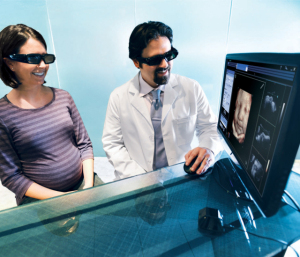by
Brendon Nafziger, DOTmed News Associate Editor | July 12, 2010
Siemens Healthcare announced it launched its syngo.fourSight Workplace, an ultrasound workstation designed for the obstetrician's office that features technology made popular by the box-office smash, "Avatar," as well as a string of children's animated movies.
The workstation, available globally July 9, comes with 3-D glasses and sophisticated 3-D processing software, to let doctors and expectant mothers see babies in "real 3-D."
"You can really see the depths of the fetus, and it's a pity we cannot simulate this at any normal computer monitor, but you really need the 3-D vision software and the glasses to get this immersive experience," Andrea Roeder, a spokeswoman for Siemens, told DOTmed news.



Ad Statistics
Times Displayed: 136675
Times Visited: 7927 MIT labs, experts in Multi-Vendor component level repair of: MRI Coils, RF amplifiers, Gradient Amplifiers Contrast Media Injectors. System repairs, sub-assembly repairs, component level repairs, refurbish/calibrate. info@mitlabsusa.com/+1 (305) 470-8013
The ultrasound workstation also features Skeletal Rendering, letting doctors better gauge the skeletal anatomy, and thus the health of the fetus, Siemens said. And it has Amnioscopic Rendering, allowing users to move a virtual light source, like a "Maglite," in the uterus, to better visualize aspects of the fetus, Malvern, PA-based Siemens said.
"You get the very photo realistic ultrasound images, which is good for maternal-fetal bonding, but also has clinical value," Roeder said.
The 3-D/4-D system is powered by NVIDIA, best known for making graphics cards for high-end gaming PCs. It runs on the company's Quadro FX and NVIDIA CUDA architecture, the company said, and uses their glasses.
Although the 3-D effects
drew crowds at shows, such as the Society for Maternal-Fetal Medicine in February and RSNA, where it debuted last year, the focus of the system is really to free up scanning time, Siemens said.
"The whole idea behind these workplaces is to free the ultrasound system from image processing and viewing," Roeder said.
The product processes and displays ultrasound images on a console separate from the scanner, freeing doctors to use the scanner simply for acquiring the images. This is especially useful in Europe, where doctors often perform the scans themselves, Roeder said.
Depending on how the workstation, which got U.S. Food and Drug Administration clearance this spring, is received, Siemens might expand it to other ultrasound applications, such as abdominal imaging.
"We're looking into this," Roeder said.

